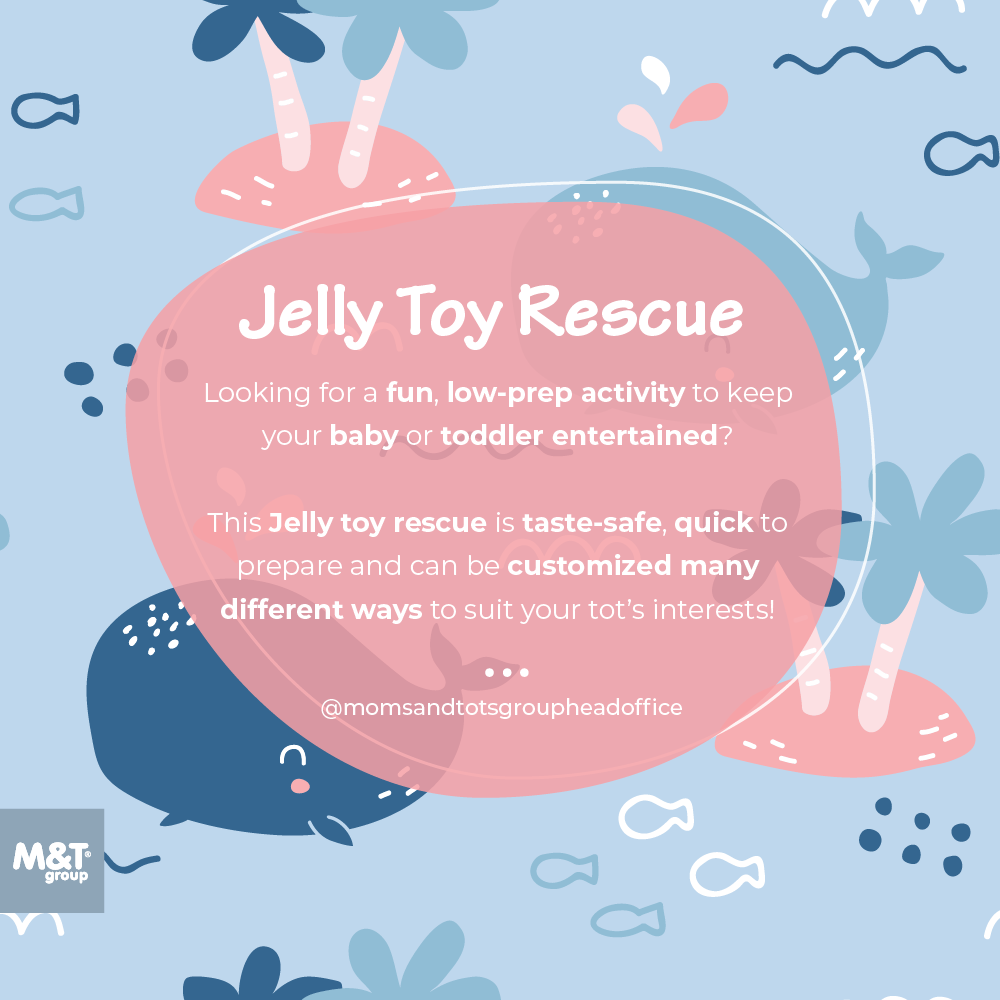Looking for a fun, low-prep activity to keep your baby, toddler or preschooler entertained? This Jell-O toy rescue is taste-safe, quick to prepare and can be customized many different ways to suit your child’s interests!
At What Age Can Babies Play with Jelly?
We love taste-safe sensory recipes because they’re a great way to allow babies and toddlers to safely partake in activities that would normally only be appropriate for older kids.
Because gelatin is taste-safe, you can make it for younger kids without worrying that they’ll be harmed if they taste it. But because gelatin becomes semi-solid when it sets, I wouldn’t recommend giving it to children who aren’t ready for solid food.
You can always reduce the quantity of gelatin to make this activity safer for infants, but it can still pose a choking hazard to children who can’t swallow food. For this reason, you should probably wait until your child is about 6 months old before attempting any sort of Jelly sensory play.
How to Prepare a Jell-O Dig
Required Ingredients
- 250ml Water
- 2 boxes Unflavoured gelatin powder (you can also use flavoured Jelly powder)
- 1ml Food colouring
Note: I prefer to use unflavoured gelatin because I don’t want to encourage my kids to eat this activity by making it taste too good, but you’re welcome to use regular Jell-O to make yours. To do so, just follow the same instructions, but skip the food colouring and use 2 boxes of Jelly per batch.
Required Supplies
You’ll also need:
- Small plastic toys
- Whisk
- Standard 9×9-inch baking dish (if you’re not comfortable letting your child play with sensory materials that are inside a glass dish, you can also use a plastic container of approximately the same size)
- Parchment or wax paper
- Jumbo plastic tweezers (optional)
Step-by-Step Instructions
1. Boil Water
Use a kettle or saucepan to bring 1 ½ cups of water to a boil.
Note: I decided to use a 9×9-inch baking dish to set up our Jelly rescue activity, but if you’d like your sensory bin to be bigger, you can always use a 9×14-inch baking dish and double all the quantities.
2. Add Food Colouring
Add food colouring to the water.
I used 3 drops of blue and 2 drops of green to create an ocean feel, but you’re welcome to experiment with different quantities depending on how dark you want your Jelly dig to look. Darker Jelly will mean that the plastic toys aren’t as visible, which can add an extra challenge for older toddlers and preschoolers.
You can also skip this step altogether if you want your Jelly to be clear once it sets.
3. Pour Gelatin into Bowl
Place 1 ½ tablespoons of powdered gelatin in a medium mixing bowl.
If your gelatin came in 7-gram packets, use two packets. If you’ve decided to use flavoured Jelly, use two 80-gram boxes.
Depending on your child’s age, you can also choose to adjust the quantities a bit to make the Jelly softer or harder.
If you’re preparing this activity for an infant, add a bit more water or reduce the quantity of gelatin to create softer Jelly and minimize the risk of choking. If you’re preparing it for an older toddler or preschooler, add a bit less water or a little more gelatin to make rescuing the toys more challenging.
4. Add Boiling Water
Pour 1 ½ cups of boiling water into the bowl and whisk until the water and gelatin are well combined. Start whisking immediately or the gelatin might seize up and you’ll have to start over from scratch.
5. Add Cold Water
Add ¾ cup of cold water and whisk until combined
6. Add Toys
Arrange some plastic toys at the bottom of a baking dish.
In order to create an ocean animal rescue bin, we decided to use sea creatures, but you don’t have to. Feel free to use whatever you like—dinosaurs, flowers, figurines from your child’s favourite TV show—or adapt it to the season by choosing items related to the nearest holiday.
You can also use large sensory items like pom-poms, LEGO, crafts buttons or foam letters. Just make sure you choose items that won’t disintegrate when exposed to water.
7. Pour Mixture into Baking Dish
Slowly pour the gelatin mixture into the baking dish.
The toys may shift a bit as you pour; if they do, you can use a spoon or fork to gently put them back into place. I love how the sea creatures and blue water made our sensory tub look like a mini Jelly aquarium.
8. Let Set
Place the baking dish in the fridge for 3-4 hours, or as long as it takes for the gelatin to set.
Once the gelatin has set, it’s time to play!





